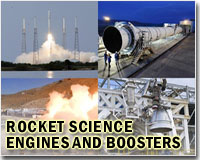 |
Huntsville AL (SPX) Sep 02, 2010 With a loud roar and mighty column of flame, NASA and ATK Aerospace Systems successfully completed a two-minute, full-scale test of the largest and most powerful solid rocket motor designed for flight. The motor is potentially transferable to future heavy-lift launch vehicle designs. The stationary firing of the first-stage development solid rocket motor, dubbed DM-2, was conducted by ATK, a division of Alliant Techsystems of Brigham City, Utah. DM-2 is the most heavily instrumented solid rocket motor in NASA history, with a total of 53 test objectives measured through more than 760 instruments. Prior to the static test, the solid rocket motor was cooled to 40 degrees Fahrenheit to verify the performance of new materials and assess motor performance at low temperatures during the full-duration test. Initial test data showed the motor performance met all expectations. "For every few degrees the temperature rises, solid propellant burns slightly faster and only through robust ground testing can we understand how material and motor performance is impacted by different operating conditions," said Alex Priskos, first stage manager for Ares Projects at NASA's Marshall Space Flight Center in Huntsville, Ala. "Ground-testing at temperature extremes pushes this system to its limits, which advances our understanding of five-segment solid rocket motor performance." The first-stage solid rocket motor is designed to generate up to 3.6-million pounds of thrust at launch. Information collected from this test, together with data from the first development motor test last year, will be evaluated to better understand the performance and reliability of the design. Although similar to the solid rocket boosters that help power the space shuttle to orbit, the five-segment development motor includes several upgrades and technology improvements implemented by NASA and ATK engineers. Motor upgrades from a shuttle booster include the addition of a fifth segment, a larger nozzle throat, and upgraded insulation and liner. The motor cases are flight-proven hardware used on shuttle launches for more than three decades. The cases used in this ground test have collectively launched 59 previous missions. After more testing, the first-stage solid rocket motor will be certified to fly at temperature ranges between 40-90 degrees Fahrenheit. The solid rocket motor was built as an element of NASA's Constellation Program and is managed by the Ares Projects Office at Marshall. ATK Aerospace Systems is the prime contractor.
Share This Article With Planet Earth
Related Links Marshall Space Flight Center Rocket Science News at Space-Travel.Com
 Launch of privately-built Danish rocket delayed: builder
Launch of privately-built Danish rocket delayed: builderCopenhagen (AFP) Aug 30, 2010 The launch into space of Denmark's first privately-built rocket has been postponed to Thursday due to bad weather conditions, one of its builders said. "The wind delayed the transportation of the rocket from Copenhagen to (the island of) Bornholm. But we hope to take our prototype on Tuesday to the launch base in order to be able to take off on Thursday," said Peter Madsen. Madsen, 39, a ... read more |
|
| The content herein, unless otherwise known to be public domain, are Copyright 1995-2010 - SpaceDaily. AFP and UPI Wire Stories are copyright Agence France-Presse and United Press International. ESA Portal Reports are copyright European Space Agency. All NASA sourced material is public domain. Additional copyrights may apply in whole or part to other bona fide parties. Advertising does not imply endorsement,agreement or approval of any opinions, statements or information provided by SpaceDaily on any Web page published or hosted by SpaceDaily. Privacy Statement |